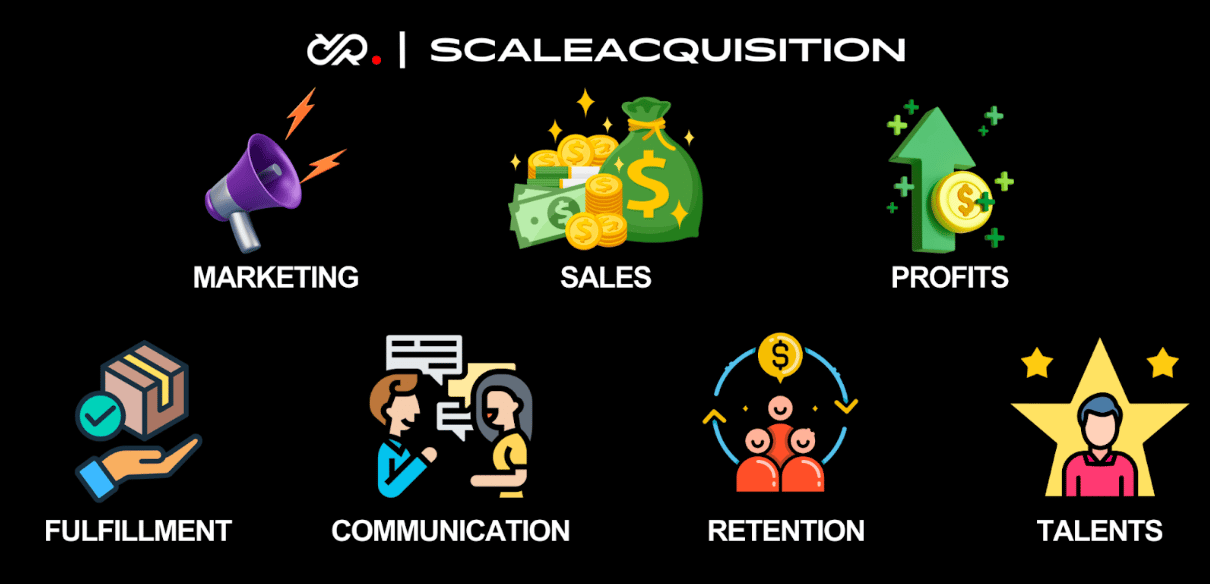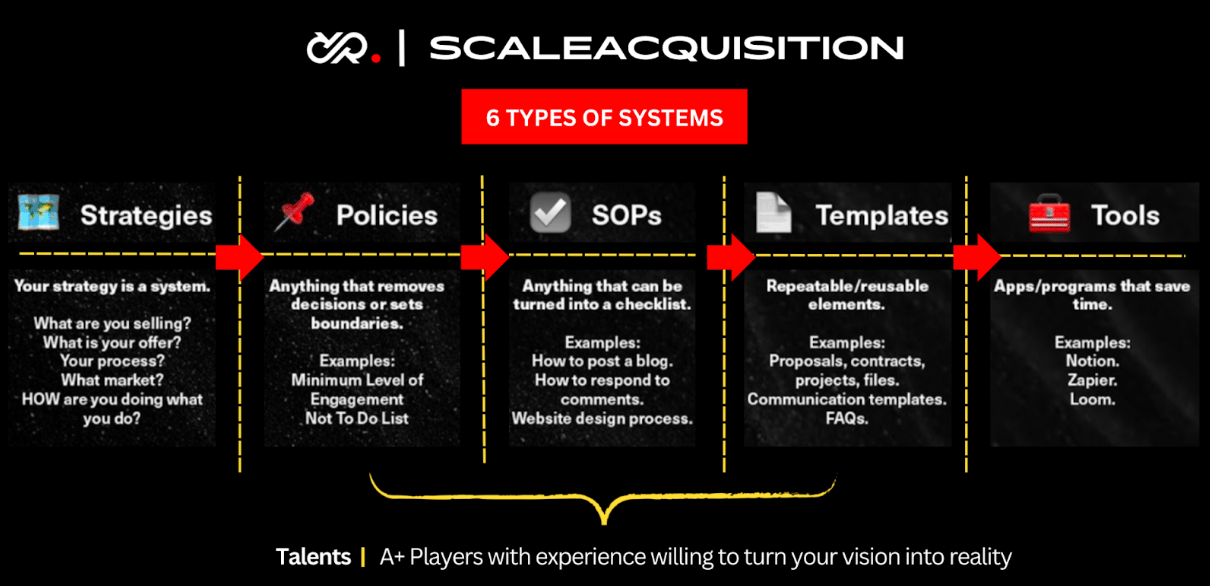
Upgrade | Advertise | Tools | 1:1Support
In today's guide:
🧰 Why start working “on” your business (instead of “in” it)
🛠️ The 5 types of systems every Systems-Builder needs
💸 5 Systems Building Principles to save you years of mistakes
🚀 The key fundamentals I use for consistent media output
Read time: 22 minutes[Message clipped?] Click “View entire message” at the bottom.
Hey,
Apologies for missing Friday’s guide but due to some projects needing delivery I completely fall back on this so I decided top go deeper with this guide. Hope you enjoy the value 😉
Now that you know how to find you audience and launch your product Idea, It’s time to move to the next phase which is growing your one-person business.
Now we all want a business that gives us freedom and flexibility.
But as your business grows, the opposite happens.
The more money you make, the more time and effort you have to put into running it.
Until you start building systems and teams to Produce, Run and Manage (PRM) everything.
And that’s what we’re going to talk about today and later give you an inside view of how I have my own business set up so you can do the same.
So, lets get started!
When you get started as a one-person business, you’ll probably be going through these 3 phases:
#1 - Starting your business
#2 - Working “in” your business
#3 - Working “on” your business

Phase 1: Starting Your Business
This is when you're figuring things out:
What’s the best tools to buy
What type of services to offer
Who might be your ideal clients
And how to get leads and or clients
You’re thinking very hard HOW TO do it all successfully and looking everywhere to who has the secret sauce to success.
Phase 2: Working "In" Your Business
Once you've figured everything out and landed your first clients, you now start working "in" your business.
You're doing the work that is exciting, but also the work you literally hate and are bad at.
You’re doing everything basically - from lead generation, to content creation, to presentations, to emails, to sales calls, to chatting, to fulfillment, to accounting, etc etc. You name it.
It’s a mess, it’s stressful and progress is painfully slow.
I’m pretty sure you can relate.
Phase 3: Working "On" Your Business (Becoming A Systems-Builder & Creator)
Now here’s the BREAKTHROUGH IDEA I want to grab firmly hold of.
If you want to build a thriving Lifestyle Business, REALISTICALLY you can’t be doing everything.
And you really don’t want to either, to be honest.
Because you’ll run out of hours in the day.
So, you need to transition from working “in” your business to working “on” your business.
That means becoming systems builder and or creator so you can remove yourself from the day-to-day operations and produce media so you can consistently get new leads…
And instead focus on the high-leverage things that really move the needle.
But before you start building your systems, there are 2 things you need to understand:
The 7 types of systems you must leverage in your business
How to avoid the most common Systems Building mistakes
And What my personal production system looks like (fully mapped out)
The 7 Types of One-Person Biz Systems
What is a One-Person Business System?
A One-Person Business System allows you to extend your productivity and growth beyond your time or reach.
You can complete projects, hit financial goals, and daily tasks, without working more hours.
As Systems-Builder/Creator, I’m going to work with you through these days to create systems for every area of your business.
Here’s what we’ll focus on:

These areas include:
📯 Marketing (lead generation)
🤑 Sales (closing sales)
💵 Profit (reinvesting & profit margins)
🎁 Fulfillment (delivering on promises)
📲 Communication (efficient communication)
♻️ Retention (client results & satisfaction)
🤝 Talents (A+ players contractors)
How do we do it?
By leveraging the power of 6 types of systems:

There are 6 distinct types of systems that allow you to remove your personal input and still create powerful results.
Strategies: Your Strategy Is Your Most Important System.
Strategies are your overarching plans and methods for achieving specific goals.
They provide direction for system-making and help you stay focused on what matters. For example, my Content Creation Strategy (which you’ll learn in the next lesson), allows me to create the content I need to reach my goals, in the least amount of time.
Policies: Anything That Removes Decisions Or Sets Boundaries.
Policies are guidelines and rules that govern behavior and decision-making within your business.
For example, I have a Minimum Level of Engagement policy which states that I don’t take on projects below my minimum rate.
Standard Operating Procedures (SOPs): Anything That Can Be Turned Into A Checklist.
SOPs are step-by-step instructions for performing recurring tasks and processes.
For example, I have a detailed SOP for responding to comments and DMs on social media, so I don’t have to do it myself.
Templates: Creating Repeatable/Reusable Elements.
Templates help save time and ensure consistency in your communications and operations.
For example, in my design agency I use a standardized branding presentation template to save time.
Tools: Apps/Programs That Save Time.
Tools are resources that help automate or simplify tasks and processes.
For example, I use Clickup (other people use Notion, Slack or Trello) to automate my client tracking and follow-up.
Talents: Other People's Skills To Execute Your Vision.
These are people who know their craft and have proven experience doing what you are hiring them for. For example: I always keep a rolodex of people.
Who’ve worked on projects of others and or been referred by other people that certain key tasks for future reference.
Most cases I work with them on a specific agreement where they are responsible for hitting certain KPI’s or in other words they work on performance basis as to help them always stay improving and or on the cutting edge of what going on in their field.
5 Timeless Systems Building Principles
Now that you know the different types of systems you have at your disposal, let’s talk about best practices.
Because the truth is, most people do Systems Building wrong.
I certainly did for a long time.
But after making the same mistakes over the years, I came up with 5 Systems Principles to build bulletproof systems:

Let me break these down for you;
Systematize what you repeat.
Focus on your most frequent and time-consuming tasks and processes first.
Don’t waste time trying to systematize one-off things.
Examples: I personally systemized the video production first while I was doing the copywriting. Then I went on to systemizing the copywriting and also outsourcing this. After this was done I went on to focus heavily on video content, advisory and sales.
Every hour spent on systems returns 10x.
Building systems is more work in the short-term.
It is often tempting to just “do it yourself.” But every time you “do it yourself,” you are hurting your future self.
So, prioritize building systems and block off time to work “on” your business.
If you don’t have a lot of time and need help, keep in mind to prioritize income producing tasks. These will be the things that will give you income to later outsource all.
Systems should be simple.
Simple systems are easier to use, teach, maintain, and improve over time.
Avoid building complicated systems at all costs.
The more complicated it is, the more bottlenecks you’ll have and the worse the business output will be.
A business should be lean, efficient and simple.
As a creator systems are for your strength.
Systems should serve you and your business, not the other way around.
Each system you build should make your life easier - otherwise, you don’t need it.
Avoid wasting time building systems for the sake of doing it rathern really focus on what you can do to make it simpler and more efficient.
The best system is saying no.
Knowing when to say no and setting boundaries is essential to build a profitable Lifestyle Business that runs without you.
The most simple (and powerful) system is just saying no.
Example: saying no to random offers, shiny-objects, and or recommendations as not everything will apply to your specific situation so evaluate carefully and then see if you truly can implement what is needed to your benefit. If not, just say no.
Media Growth Publishing Process Overview
As you’ve seen by now, you don’t have to do everything yourself.
If you create a process (as in my own version below) you will be able to produce content as scale meanwhile focusing on what you’re good at. Your Skill and or Talent.

IMPORTANT: The overview view above is for you to understand the process and in the next email I’ll explain much more in-depth how each step is executed.
The overview above starts with;
Me doing my personal research, curating content, and creating my main guide for the week (this is published ONCE a week while that gets supported by two other smaller emails after the 15-Day Email Course.)
The Copywriter (outsource) Turns the guide into a SEO optimized guide for my website blog for google keyword ranking. (you’ll learn more of my website SEO strategy in a different guide)
The same guide (SEO optimized) gets used as a foundational source and gets mixed with trending topics for the rest of contents like; Medium, Twitter(x), Threads, LinkedIn, Twitter tweets and Threads.
Based on the Guide I also create a long form YouTube video that is Face-to-camera edited with screen share. This way it can be used as Shorts, Reels, or Long-form educational material distributed among Youtube, Instagram, Facebook (as primary) and Pinterest, Google my business, etc (as secondary).
In the end all of this gets converted and edited into a podcast. (every reference, example, or related information has to be explained in detail to be understood audio wise and also the snippets itself (if found) will be inserted.)
An example of that will be is…
If I refer to someone specific and or what they say in another video, the editor will take that piece and add it in the video (audio as well) this way my information is corroborated by the listener or viewer.
So yes, It’s a well oiled machine that gives me consistent output, but guess what…
It saves me time, makes me much more productive and gives me freedom to do what I love.
And that’s what I want to help founders achieve when working with me in my weekly group advisory for a fraction of what you’ll pay for a cohort or coaching program sold else where.
Ready to start building?
In the following lessons, we’ll take a deep-dive into 5 of my One-Person Business Systems.
And I’ll show you how to implement them in your business.
Tomorrow, I’ll break down my Video Content Creation System.
And by the end of that lesson, you’ll have a proven process for creating high-converting content like clockwork.
So, be on the lookout for that.
Let’s grow together! 🚀

Renald Croes
CEO of ScaleAcquisition.com
PS. Enjoying the Six-Figure One-Person Business Email Course? Then you should check out my weekly group advisory/service packages 🚀Let Us Help You Build Your Business.
PPS. Don't want to receive my Seven-Figure Blueprint Lessons anymore? Email me at [email protected] and I’ll gladly remove you from my newsletter. No hard feelings. 😉
